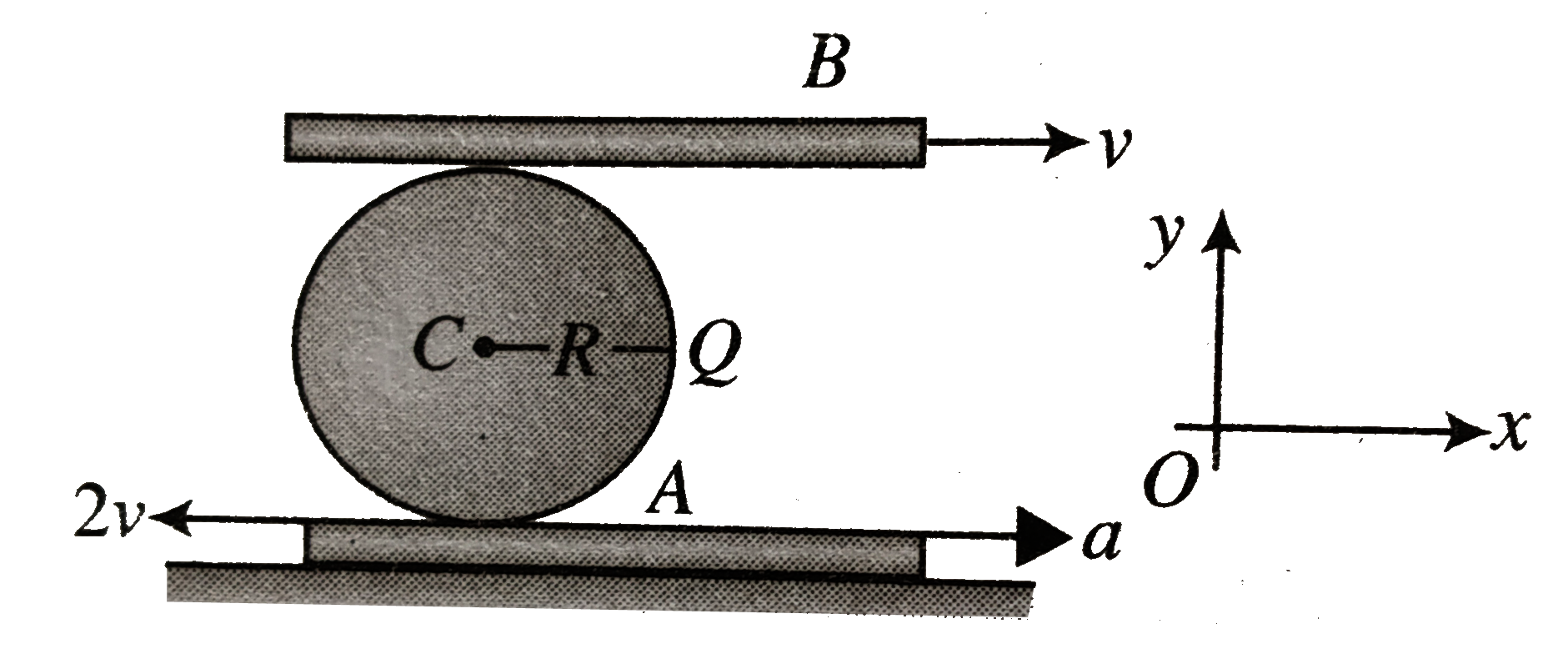Passage - II
A cylinder rolls on the plank A and B without relative sliding. C and Q are the points on the axis and surface respectively and line CQ is horizontal. The planks move with velocities −2Vˆi,Vˆi respecticely

If ¯¯¯VC and ¯¯¯VQ are the velocities at the points C & Q then ¯¯¯VC−¯¯¯VQ is
V(+ˆj)
3V2(+ˆj)
3V2(−ˆj)
V2(−ˆj)
The correct Answer is:B
Topper's Solved these Questions
- ROTATIONAL DYNAMICS BOOK - AAKASH SERIESCHAPTER - ROTATIONAL DYNAMICS EXERCISE - PRACTICE SHEET (Exercise - IV) (LEVEL - II Matrix Matching Type Questions)
2 Videos
- ROTATIONAL DYNAMICS BOOK - AAKASH SERIESCHAPTER - ROTATIONAL DYNAMICS EXERCISE - PRACTICE SHEET (Exercise - IV) (LEVEL - II Integer Type Questions)
6 Videos
- ROTATIONAL DYNAMICS BOOK - AAKASH SERIESCHAPTER - ROTATIONAL DYNAMICS EXERCISE - PRACTICE SHEET (Exercise - IV) (LEVEL - II More than One correct answer type Questions)
6 Videos
- RIVISION EXERCISEBOOK - AAKASH SERIESCHAPTER - RIVISION EXERCISEEXERCISE - MOTION IN A PLANE (LAMNI.S THEOREM)
6 Videos
- ROTATIONAL MECHANICSBOOK - AAKASH SERIESCHAPTER - ROTATIONAL MECHANICSEXERCISE - Questions for Descriptive Answers
20 Videos
Similar Questions
A cylinder rolls on the planks A and B without relative sliding. If the planks move with velocities −2vˆi,vˆi respectively and the plank A has acceleration →a(=aˆi), find the: (a) vC and vQ and (b) aC and aQ.

View SolutionA cylinder rolls on the planks A and B without relative sliding. If the planks move with velocities −2vˆi,vˆi respectively and the plank A has acceleration →a(=aˆi), find the: (a) vC and vQ and (b) aC and aQ.

View Solution
Knowledge Check
If ¯b=2ˆi+ˆj−ˆk,¯c=ˆi+3ˆkand¯a is a unit vectors, then the maximum value of [¯a¯b¯c] is
A√59B1C3D7If ¯a,¯b,¯c are position vectors of points A, B, C respectively such that 5¯a−3¯b−2¯c=0, then
AC divides BA in internally in the ratio 5:3BC divides BA in externally in the ratio 5:3CC divides AB in internally in the ratio 5:3DC divides AB in internally in the ratio 5:3If ¯a=ˆi+2ˆk,¯b=2ˆi+ˆj,¯c=ˆj+2ˆk, then ¯a⋅(¯bׯc)=
A1B2C4D6
If v2,v2, and v3 are the velocities of points P,C and Q respectively lying on body doing pure rolling motion, then correct order of velocities will be
View SolutionIf the points A(¯a),B(¯b),C(¯c) are collinear and 3¯a+2¯b−5¯c=¯0, then
View SolutionIf the points A(¯a),B(¯b),C(¯c) are collinear and 2¯a+3¯b−5¯c=¯0, then
View SolutionIf ¯aand¯b are position verctors of A and B respectively, then the position vector of point C in produced AB such that ¯¯¯¯¯¯AC=3¯¯¯¯¯¯AB is
View SolutionIf vectors ¯a=2ˆi+3ˆj+4ˆk,¯b=ˆi+ˆj+5ˆkand¯c form a left handed system, then ¯c is
View Solution
